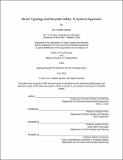Street typology and bicyclist safety : a systems approach
Author(s)
Minikel, Eric Vallabh
DownloadFull printable version (7.509Mb)
Other Contributors
Massachusetts Institute of Technology. Dept. of Civil and Environmental Engineering.
Advisor
Joseph Ferreira.
Terms of use
Metadata
Show full item recordAbstract
Cycling is an attractive transportation mode but has not attained a large mode share in the United States, in part because it is correctly perceived as dangerous. Much literature on cyclist safety and the built environment has focused on bicycle facilities such as bike lanes, while fewer studies have addressed route choice, specifically side streets versus arterials. The cities of Berkeley, CA and Cambridge, MA have pursued opposite strategies, Berkeley creating “bicycle boulevards” out of residential side streets while Cambridge has added bike lanes to major arterial roads. I hypothesize that side streets are safer than arterials regardless of which street has been treated for cyclists, both in terms of collision rate and fraction of collisions that are severe. For each city, I use cyclist count data with police-reported bicycle-motor vehicle collision data to compute relative collision rates for pairs of parallel streets that are alternate routes to reach the same destinations. In a detailed analysis of Berkeley I find that bicycle boulevards have categorically lower collision rates than arterials, with no difference in severity. I demonstrate, with very limited data, how to apply the same methodology to Cambridge and find results somewhat suggestive that side streets have lower collision rates than arterials. I highlight shortcomings in current data collection practices that make this research difficult.
Description
Thesis (M.C.P.)--Massachusetts Institute of Technology, Dept. of Urban Studies and Planning; and, (S. M. in Transportation)--Massachusetts Institute of Technology, Dept. of Civil and Environmental Engineering, 2010. This electronic version was submitted by the student author. The certified thesis is available in the Institute Archives and Special Collections. Cataloged from student-submitted PDF version of thesis. Includes bibliographical references (p. 98-100).
Date issued
2010Department
Massachusetts Institute of Technology. Department of Civil and Environmental Engineering; Massachusetts Institute of Technology. Department of Urban Studies and PlanningPublisher
Massachusetts Institute of Technology
Keywords
Urban Studies and Planning., Civil and Environmental Engineering.